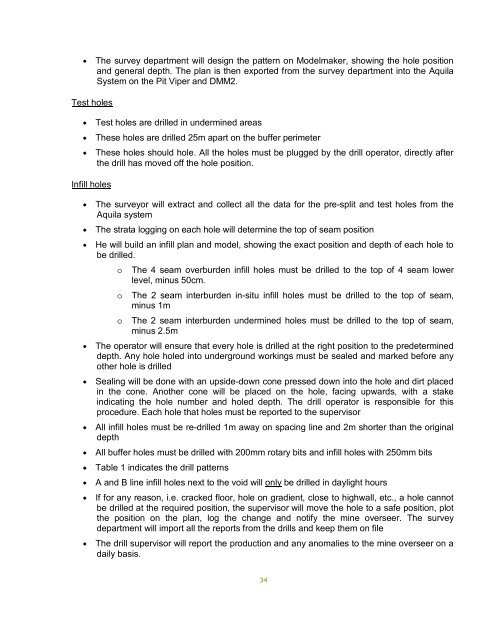prevention and control of spontaneous combustion - Mining and
prevention and control of spontaneous combustion - Mining and
prevention and control of spontaneous combustion - Mining and
Create successful ePaper yourself
Turn your PDF publications into a flip-book with our unique Google optimized e-Paper software.
• The survey department will design the pattern on Modelmaker, showing the hole position<br />
<strong>and</strong> general depth. The plan is then exported from the survey department into the Aquila<br />
System on the Pit Viper <strong>and</strong> DMM2.<br />
Test holes<br />
• Test holes are drilled in undermined areas<br />
• These holes are drilled 25m apart on the buffer perimeter<br />
• These holes should hole. All the holes must be plugged by the drill operator, directly after<br />
the drill has moved <strong>of</strong>f the hole position.<br />
Infill holes<br />
• The surveyor will extract <strong>and</strong> collect all the data for the pre-split <strong>and</strong> test holes from the<br />
Aquila system<br />
• The strata logging on each hole will determine the top <strong>of</strong> seam position<br />
• He will build an infill plan <strong>and</strong> model, showing the exact position <strong>and</strong> depth <strong>of</strong> each hole to<br />
be drilled.<br />
o The 4 seam overburden infill holes must be drilled to the top <strong>of</strong> 4 seam lower<br />
level, minus 50cm.<br />
o The 2 seam interburden in-situ infill holes must be drilled to the top <strong>of</strong> seam,<br />
minus 1m<br />
o The 2 seam interburden undermined holes must be drilled to the top <strong>of</strong> seam,<br />
minus 2.5m<br />
• The operator will ensure that every hole is drilled at the right position to the predetermined<br />
depth. Any hole holed into underground workings must be sealed <strong>and</strong> marked before any<br />
other hole is drilled<br />
• Sealing will be done with an upside-down cone pressed down into the hole <strong>and</strong> dirt placed<br />
in the cone. Another cone will be placed on the hole, facing upwards, with a stake<br />
indicating the hole number <strong>and</strong> holed depth. The drill operator is responsible for this<br />
procedure. Each hole that holes must be reported to the supervisor<br />
• All infill holes must be re-drilled 1m away on spacing line <strong>and</strong> 2m shorter than the original<br />
depth<br />
• All buffer holes must be drilled with 200mm rotary bits <strong>and</strong> infill holes with 250mm bits<br />
• Table 1 indicates the drill patterns<br />
• A <strong>and</strong> B line infill holes next to the void will only be drilled in daylight hours<br />
• If for any reason, i.e. cracked floor, hole on gradient, close to highwall, etc., a hole cannot<br />
be drilled at the required position, the supervisor will move the hole to a safe position, plot<br />
the position on the plan, log the change <strong>and</strong> notify the mine overseer. The survey<br />
department will import all the reports from the drills <strong>and</strong> keep them on file<br />
• The drill supervisor will report the production <strong>and</strong> any anomalies to the mine overseer on a<br />
daily basis.<br />
34

















